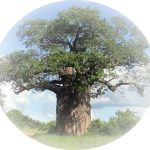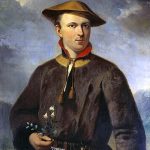
TREE LIFE 535
MARCH 2025
PLANNED EVENTS: MARCH
Since inclement weather or other issues may vary our plans, WhatsApp Tony Alegria on 0772 438 697 to join our WhatsApp group for last-minute updates.
Saturday 1st March 2025: visit to the National Botanic Gardens. Meet at 8.30 in the main car park and join us for a morning looking at trees that catch our interest.
Main meeting Sunday 16th March 2025: Greystone Park Nature Reserve. Meet at 9.30 to enjoy this lovely green area and support the wonderful work that Neil Fairlie and the team have been doing there.
Please check your WhatsApp for details (including “weather” the outing has been finalised due to rainy conditions!)
REPORTS FROM PREVIOUS OUTINGS
Saturday 1st February 2025: National Botanic Garden Outing
By Tony Alegria, photos by Mark Hyde and Bart Wursten
No threat of rain on this pleasantly warm Saturday morning. Ladies present: Ann Sinclair, Dawn Siemers, Dido de Swardt, Sonya Messick and Linda Hyde who was exercising her new knees. The guys: Charles Crawshaw, Jan van Bel, Mark Hyde, Paul Grobler and Tony Alegria.

Homalium abdessammadii
The first tree we looked at was the Homalium abdessammadii. This tree can get pretty big in its natural habitat in the Victoria Falls area. However, this one has been bigger than it is now and judging by the stump, it’s still managing to hang on. Strangely enough it was looking healthier today than it has been in the past few years. No amazing looking flowers at the moment but it was in bud so we’ll have another show in the not-too-distant future.
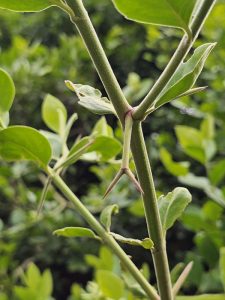
Y shaped thorns of Carissa edulis
The big bush of Carissa edulis nearby had one solitary fruit and besides the straight thorns, scattered amongst them was the odd Y-thorn. Although there is a milky sap and the fruit is also milky, however, like the paw-paw and other milky plants, the fruit once ripe is no longer milky. Once the milk has gone the Carissa edulis has a very tasty, sweet edible fruit which can be enjoyed.
We then compared two trees that were growing side by side. The first observation was that they both had simple leaves, but one was a darker green than the other. Of note was that the Common Red-milkwood Mimusops zeyheri had the alternate darker green leaves with white milky sap, a longish petiole and slightly raised ridge on top. The Pock-Ironwood Chionanthus battiscombei had opposite leaves with shorter petioles and no raised midrib ridge, but had hair-tuft domatia along the midrib which is indented above.
We wondered if all Mimusops species had a slightly raised midrib and later in the day looked at a Mimusops afra which did.
The swamp fig Ficus trichopoda (synonym Ficus hippopotami) does not occur in Zimbabwe but is native to coastal swamps. It coppices from roots and any branch that touches the ground, thus resulting in an ever widening circle of trees. The tree we looked at demonstrated this beyond any doubt!
The Usambara fig Ficus usambarensis from north of Zimbabwe has very thick growing tips and thick green leaves that crackle loudly when crunched, very much like dry leaves would do.
The Birds Egg fig Ficus ottoniifolia ssp. macrosyce did not disappoint us! Although some figs seem to be present all year round, this was the most figs I had ever seen on the three trees. The southern limit for this fig is northern Zambia.
e had a quick look at a tree that we had recently identified after our week’s botanising trip to Matabeleland South, Entandrophragma caudatum, the Wooden-banana. We have found three of these trees in the National Botanic Garden but in all the years of botanising have never seen their diagnostic fruit. The wooden-banana is dioecious, with male and female flowers on separate plants. So, we don’t know if they are all male or female!
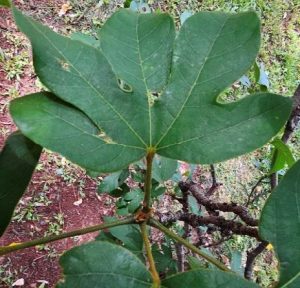
Cola millenii
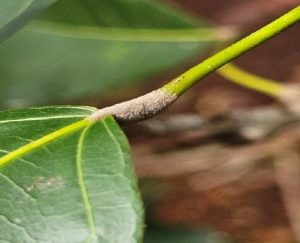
Cola greenwayi
Earlier on we had taken a leaf from the Cola millenii near the path to compare with a that was not that far away. What is distinctive about the Colas is the pulvinus at the base of the leaf as well as the normal end where the leaf is attached to a branchlet. The Cola greenwayi has a simple leaf whilst the Cola millenii has a 3-5-lobed leaf, so they look very different!
We also compared the Craibia brevicaudata with a Craibia affinis from Tropical Africa. The C. affinis has narrower leaves that are not wavy.
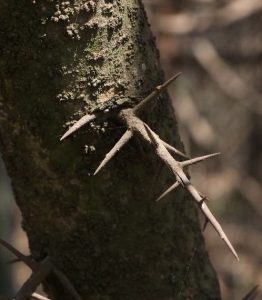
Flacourtia indica
Some of the other trees we looked at that are not mentioned above: Tara spinosa, Ficus chirindensis, Ficus bubu, Sterculia appendiculata, Kigelia africana and a Flacourtia indica that had vicious-looking compound thorns.
Main meeting 15th February 2024:
Visit to Katrin and Steve Gamble’s lovely garden
By Mark Hyde, photos by Mark Hyde and Petra Ballings
This outing was a return visit to the large (5-acre) garden of Steve and Katrin Gamble in Kent Road after an 8-year gap. The Society has been there twice before on 28 January 2017 and 25 November 2017. Both these visits were written up in detail and are online (links are given below).
Identifying plant species in gardens is challenging, indeed more so than naming plants in the wild. In the wild, you can be pretty sure that an unknown tree species is to be found somewhere within the pages of Coates Palgrave’s Trees of Southern Africa, although actually locating it may not be easy.
However, there is no convenient equivalent of Coates Palgrave for cultivated trees, and it would be difficult to write one which was complete because of the open-ended nature of cultivated plants. After all, anyone can import any species and cultivate it. There are, furthermore, the issues of variation through horticultural selection and hybridisation to a greater degree among cultivated species.
In practice, things are not as difficult as the previous paragraphs might suggest. There is a ‘suite’ of plant species which are found in most Harare gardens and which we see over and over again. There are also two useful checklists of Zimbabwean cultivated plants, namely Peter Biegel’s paper and Alfred Maroyi’s update (details of both are given below) which act as helpful guides. There are also herbarium specimens, mostly collected by Biegel, in the National Herbarium.
However, certain “specialist gardens” are notable exceptions. For example, the remarkable collection of palm trees grown by the late Erik Morris in his Harare garden. Palms from all over the world were grown there and most of the species would not be found in the local horticultural trade or in other Harare gardens apart perhaps from the gardens of other specialists.
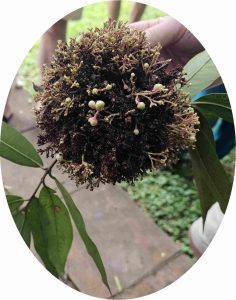
Gall on Syzygium jambos
The Gambles’ garden is not a specialist garden in that sense, but it is a mature garden with a large number of species. As the species to be found there have already been described well in Jan’s account in Tree Life 448, I will concentrate on observations that were new or of particular interest to me.
The Rose apple, Syzygium jambos, native to Asia, is commonly cultivated in Harare gardens for its ornamental appearance and edible fruit. Of interest here was the presence of a large pendulous, much-branched, spherical gall. This type of gall appears to be a feature of species of Syzygium; we generally see it on Syzygium guineense, but I also have records of it on S. cordatum (at St John’s Prep School and Chapungu Sculpture Park) and S. afromontanum (at 131, Enterprise Road).
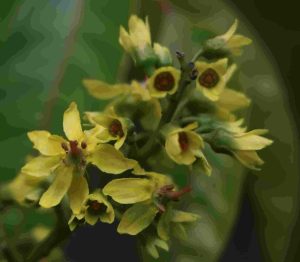
Koelreuteria elegans subsp. formosana
Species of Koelreuteria (Golden rain trees) are often to be seen in Harare. They are flowering now, showing large terminal panicles of yellow flowers. Later in the year pink bladder-like capsules will appear. There are only 3 species of Koelreuteria in the world (one has two subspecies) and I have had great difficulty in deciding which species occur in Harare. All three names have been used. Based on the clearly 2-pinnate leaves with very long acuminate apices I believe the commonest species and the one we saw on this day to be K. elegans subsp. formosana (sometimes known as K. henryi); but I still stand to be corrected. K. paniculata, a name often used, has leaves that, although technically 2-pinnate, usually only the lower pinnae are pinnate and the upper are not.
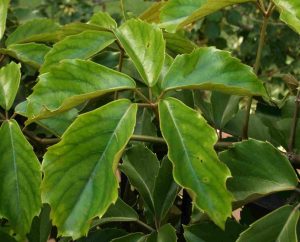
Tetrastigma voinierianum
Another unusual species in the Gambles’ garden is Tetrastigma voinierianum, Chestnut vine, a climbing species from the grape family, Vitaceae. It is a very robust climber and grows on the stone terrace near where we had tea. Its 5-lobed compound leaves are very thickly fleshy. The generic name refers to its 4-lobed stigma and the species is named after French veterinary surgeon M. Voinier, who sent a specimen of the plant to botanist Charles Baltet. It is another exotic species and hails from Asia, specifically Laos and Vietnam.
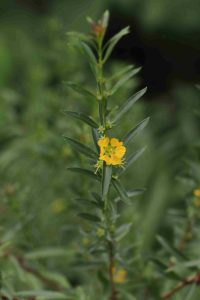
Heimia salicifolia
A totally new species for me was a Heimia, probably Heimia salicifolia. This attractive small, yellow-flowered shrub belongs to the Lythraceae family. This family has a number of trees (Lagerstroemia indica, the Pride of India, being one example) and also numerous small aquatic plants. This species comes from America and ranges from Texas south to Argentina.
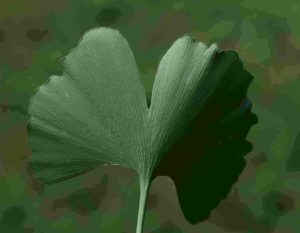
Ginkgo biloba
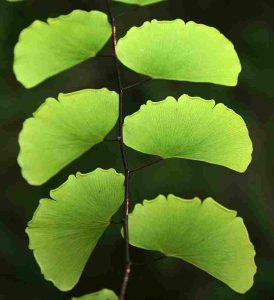
Adiantum lunulatum leaves
Near the bottom of the garden is a Ginkgo biloba, the Maidenhair tree, the famous living fossil, the sole surviving species of an ancient group of trees dating back more than 200 million years. The specific name, biloba, refers to the 2-lobed leaves, although one may note that they are not always lobed. The Maidenhair name comes from the similarity of the leaves to those of Maidenhair ferns, species of Adiantum.
Editors’ note: Six Ginkgo biloba trees were some of the only living things to survive the atomic bombing of Hiroshima in 1945. It is believed that these trees managed to survive the asteroid that killed the dinosaurs and the bomb because their roots grow deep enough in the soil that they were protected from the incinerating heat.
The afternoon ended with a splendid tea organised by our hosts. Our thanks go to Steve and Katrin for their warm welcome and hospitality.
References:
Biegel, H.M. (1977). Check-list of ornamental plants used in Rhodesian parks and gardens. Rhodesia Agricultural Journal. Research Report No. 3.
Lovemore, Mary (2017). Outing to the Gambles, 28 January 2017. Tree Life 439. https://treesociety.org.zw/tree-life/439/.
Maroyi, A. (2006). Preliminary checklist of introduced and naturalized plants in Zimbabwe. Kirkia 18(2) 177-247.
Van Bel, Jan (2017). Outing to Steve and Katrin Gamble, 25 November 2017. Tree Life 448. https://treesociety.org.zw/tree-life/448/.
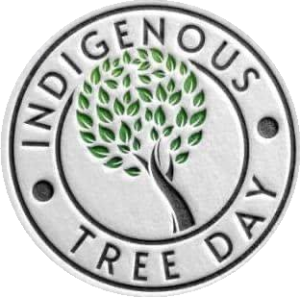 FROM THE WALRUS TO THE CARPENTER
FROM THE WALRUS TO THE CARPENTER
INDIGENOUS TREE DAY: 15 APRIL
Indigenous Tree Day is distinct from National Tree Planting Day held on the first Saturday in December and arises because estimates indicate that up to three-quarters of unnamed vascular plants are probably already threatened with extinction.
To find out which these threatened trees are one consults the “Red data list”. This is an international list of threatened and endangered species that are considered to be at high risk of extinction, and which provides an assessment of the conservation status of various plant, animal, and fungi species.
There are various classifications, “Extinct” or “Extinct in the Wild” followed by “Critically Endangered”, “Endangered” and “Vulnerable”. The risk factors reduce from there until they have insufficient information to assess the risk of extinction so categorise them as “Data Deficient”.
A partial list of Red Data List species in Zimbabwe can be found on the Zimbabwe Flora website, which shows that there are over 500 endangered species in our country. Of these over 130 are endemic and a further 100 nearly endemic.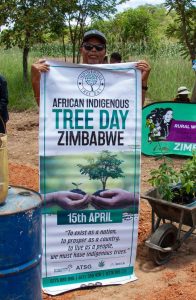
To exist as a nation,
To prosper as a country
To live as a people
We must have indigenous trees!
So join Busi Malunga and the children from Chindunduma High school and plant an indigenous tree.
There are many quotes about planting trees, I like this African proverb that says,
“The best time to plant a tree is 20 years ago. The next best time to plant a tree is today.”
And then the Greek proverb that reads,
“A society grows great when old men plant trees whose shade they know they shall never sit in.”
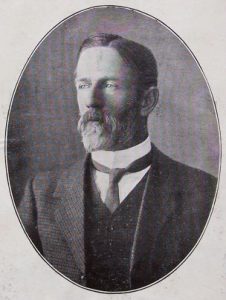
FREDERICK EYLES
“THE FATHER OF RHODESIAN BOTANY”
FREDERICK EYLES
“THE FATHER OF RHODESIAN BOTANY”
Some of the names we may be familiar with are Digitaria eylesii, Indigofera eylesiana, Barleria eylesii, Isoglossa eylesii, Rhus eylesii, Afrosciadium eylesii, Euphorbia eylesii, Aspidoglossum eylesii, Pavetta eylesii or Gutenbergia eylesii. But who was Frederick Eyles?
Born in 1864 in Gloucestershire, he became known as an author, botanist, politician and journalist, a man of wide ranging interests. He moved to Africa and arrived in Bulawayo in 1899 where he acted as editor for the weekly publication of The Bulawayo Observer until 1904. However, to know him better we need to fit him into a varied timeline
1899: became a founder member of the Rhodesia Scientific Association
1900: his book Zulu Self-Taught was published
1902: he wrote a paper “On a cave with Bushman drawings in the Matopos”
1903: he published “The collection of natural history specimens”
1906: he presented a paper on “Ferns and fern allies of Southern Rhodesia”
1907: another publication was “Notes on the habits of a young genet”
1907: he announced that he was compiling a catalogue of Rhodesian plants to which end he had put together an extensive herbarium. Indeed, for the remainder of his life he concentrated on Rhodesian flora
1910: he relocated to Mashonaland
1911: he presented “A preliminary list of the plants of Southern Rhodesia”
1914: he joined the Department of Agriculture as a statistician and water registrar
1916: the publication of “A record of plants collected in Southern Rhodesia”, the first national plant checklist only superseded in 2004 by Mapaura & Timberlake!
1920: he published “Constituents of the flora of Southern Rhodesia”
1921: he compiled the Report of the director of census dealing with the census taken on 3 May 1921
1923: he joined the Department of Agriculture and edited the Rhodesia Agricultural Journal
1924: “Diseases of cotton in Southern Rhodesia” and “Some diseases of tobacco in Rhodesia”
1926: after spending 6 months studying mycology and plant pathology at the University of Stellenbosch he published a list of plant diseases
1927: he wrote “Ecological notes on the flora of Salisbury commonage”
1928: he became curator of the Queen Victoria Memorial Library
1937: he died of pneumonia contracted on a collecting trip to the Gatooma district, and was survived by his second wife, Joanna Eyles, his son Eric Eyles and son-in law R. A. Cox.
The 1903 paper concluded with the idea that
“Whatever you do, collect something. You will find that in the progress of collection interest is awaked, then classification attempted, followed by study, observation, experiment, discovery and honour!”
During the period 1901 to 1937 he collected some 9,000 botanical specimens which were lodged in the Government Herbarium and the National Botanic Gardens, with duplicate sets at Kew, the British Museum and the National Herbarium in Pretoria. His collection of fungi was kept at the Department of Agriculture in Salisbury, and at the Mycological Herbarium at Pretoria.
“Publish and be damned”
Excelsa No 11 contains an article by Michael J Kimberley with further information. This brief note is written with acknowledgements to the Biographical Database of Southern African Science, Wikipedia and the internet.
SOCIETY COMMITTEE AND CONTACTS
Chairman Tony Alegria tonyalegria47@gmail.com 0772 438 697
Vice Chairman Mark Hyde mahyde@gmail.com 0772 233 751
Honorary Treasurer Bill Clarke wrc@mweb.co.zw 0772 252 720
Secretary Teig Howson teig.howson@gmail.com 0772 256 364
Venue Organiser Ann Sinclair jimandannsincs@zol.co.zw 0772 433 125
Committee Member Jan van Bel jan_vanbel@yahoo.com 0772 440 287
Committee Member Ryan Truscott ryan.kerr.truscott@gmail.co 0772 354 144
Committee Member Sibusiso Malunga busimalunga@yahoo.com 0775 889 898
Tree Life Editor Linda Hyde Lmharwin@pentact.co.zw 0772 232 075
Tree Society Website https://treesociety.org.zw/
Tree Society Facebook https://www.facebook.com/groups/ztreesociety/
Flora of Zimbabwe: https://www.zimbabweflora.co.zw/
Flora of Tropical Africa: https://plants.jstor.org/collection/FLOTA

